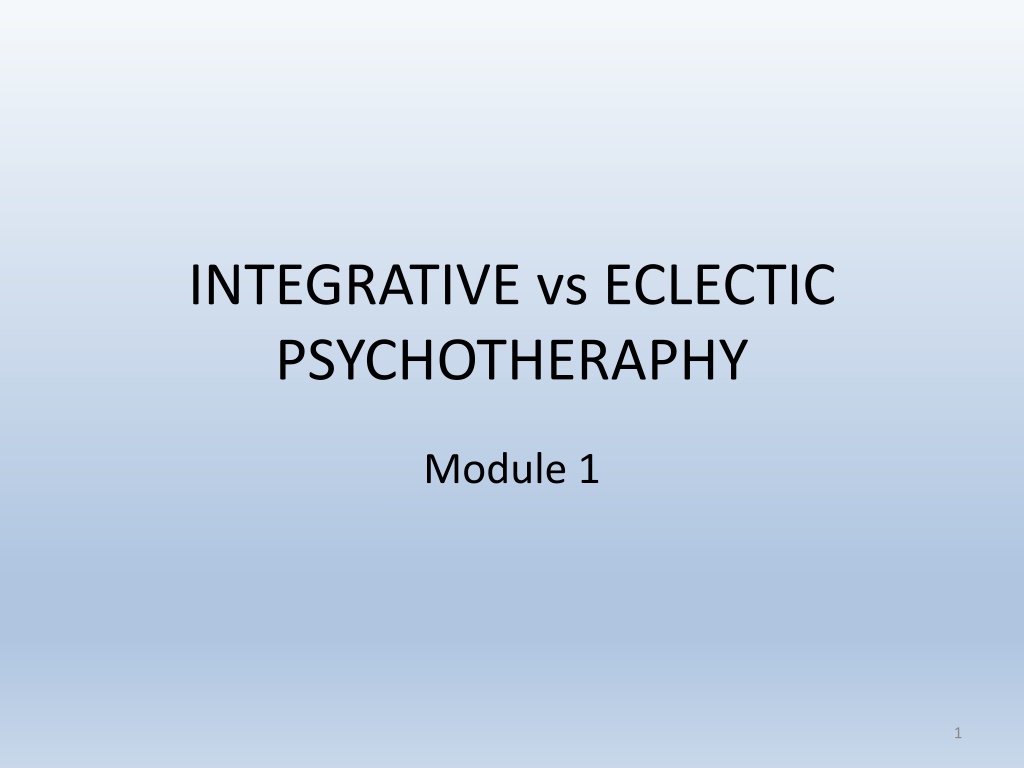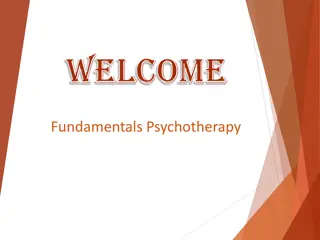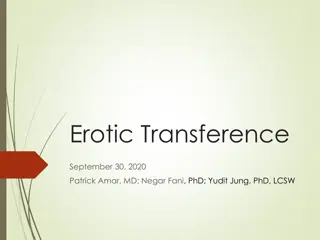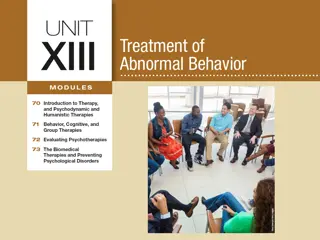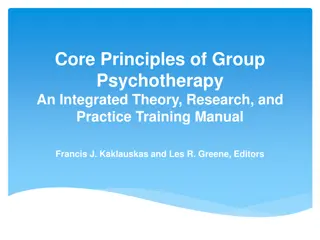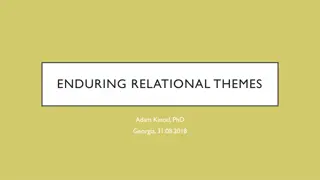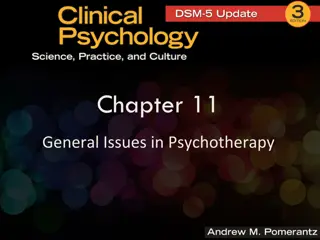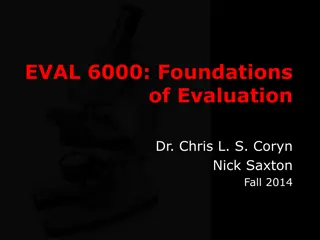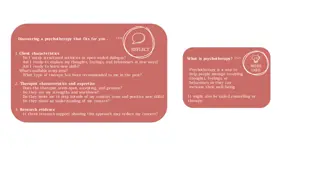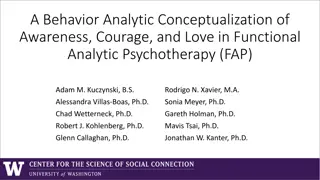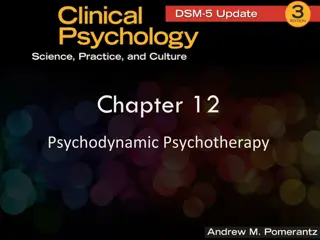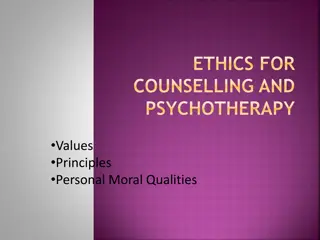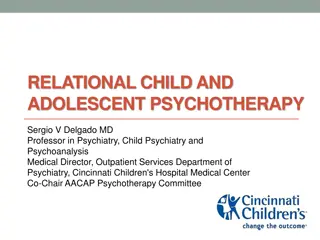Understanding Integrative and Eclectic Psychotherapy Approaches
Integrative Psychotherapy emphasizes treating individuals holistically across affective, behavioral, cognitive, and spiritual dimensions. It incorporates various theoretical perspectives like psychodynamic, client-centered, behaviorist, and cognitive therapies. Common factors in psychotherapy play a crucial role in different approaches, focusing on aspects like therapeutic alliance and positive change expectations. The eclectic approach to therapy integrates diverse techniques from multiple theoretical frameworks to tailor treatment to individual needs.
- Integrative Psychotherapy
- Eclectic Therapy
- Common Factors
- Therapeutic Alliance
- Theoretical Integration
Download Presentation

Please find below an Image/Link to download the presentation.
The content on the website is provided AS IS for your information and personal use only. It may not be sold, licensed, or shared on other websites without obtaining consent from the author. Download presentation by click this link. If you encounter any issues during the download, it is possible that the publisher has removed the file from their server.
E N D
Presentation Transcript
INTEGRATIVE vs ECLECTIC PSYCHOTHERAPHY Module 1 1
Integrative Psychotherapy Integrative Psychotherapy embraces an attitude towards the practice of psychotherapy that affirms the inherent value of each individual. It is a unifying psychotherapy that responds appropriately and effectively to the person at the affective, behavioral, cognitive, and physiological levels of functioning, and addresses as well the spiritual dimension of life. 2
Integrative Psychotherapy Takes into account many views of human functioning: The psychodynamic, Client-centered, Behaviorist, Cognitive, Family therapy, Gestalt therapy, Body-psychotherapies, Object relations theories, Psychoanalytic self psychology, and Transactional Analysis Latest research has indicated that psychotherapy is moving toward an integrated approach to therapy (Norcross, 2005). 3
Routes to psychotherapy integration There are four main routes to integrative psychotherapy: Common factors Technical eclecticism Theoretical integration and Assimilative integration (Norcross & Goldfried, 2005). 4
COMMON FACTORS IN PSYCHOTHERAPY These refer to aspects of psychotherapy, present in most approaches to treatment. A universally applied techniques can be seen regardless of the theoretical approach, because it is common to all of them (Striker, 2010) and the commonalities are more important than the differences. A list of common factors would include: A therapeutic alliance; Offering new corrective emotional experience; Expectations by the therapist and client for positive change. Therapeutic qualities such as empathy, attention, and positive regard, giving the client a rationale for problems, and the use of some systematic therapeutic procedure The therapist-client relationship was a main common factor. 5
Other common factors identified in major schools of psychotherapy include: Interpretation, Insight, and understanding; cognitive modifications; Emotional expression and release; Reinforcement; Desensitisation; Relaxation; Psycho-education Support; Expectations; Exposure and confronting a problem; 6
Eclectic Approach To Psychotherapy Eclectic therapy is an integrative form of psychotherapy. This approach adapts to the unique needs of each specific client, depending on the problem, goals and the client s expectations and motivation (Norcross J.C., 1986). Eclectic comes from the Greek word choose ; not only does the therapist use different therapies, but they go through some process to choose each one. With eclectic therapy, the goal is to use the specific type of therapy that's right for the client. A therapist who takes an eclectic approach is one who tailors each part of the therapeutic experience to your specific needs. They choose the specific type, style, and techniques that work best for you. 7
Integrative vs Eclectic Different Methods for Different Issues Since an eclectic approach to psychotherapy is one that uses several different types of therapy as needed, it works well for people who have more than one issue. Many people start therapy with several different issues they want to deal with, and the therapist may use different types of therapy for each of those issues. For example, if you want to conquer a phobia but also want to address generalized anxiety, the therapist might use a desensitization technique for the phobia and mindfulness-based therapy to help with the anxiety. Theoretical integration approach is about the knowledge of various developmental theories in order to provide therapeutic intervention to psychosocial needs and problems during the flow of life events within individual, group (family and other groups) and community by focusing on human behaviour from birth, addressing the individual as a whole within systems and relationships. 8
Avoiding confusion within the therapeutic process When an eclectic therapist moves too quickly from one type of therapy to another, you might feel confused about what's happening in your sessions. A skilled therapist can eliminate that confusion by letting you know at the end of one therapy session what you'll be doing in the next session, explain it briefly, and ask if the client has any questions. Then, when you return, they can remind you what's going to happen. 9
Assimilative & Theoretical Integration In assimilative integration methods and techniques are not simply appropriated from other modalities; they are chewed up and digested so that when they appear in a person s practice, they are thoroughly consistent with the main established theory that informs the clinician s practice and are somewhat altered by their new contexts. Assimilative integration is the incorporation of perspectives and/or practices from other clinical modalities within one s primary theoretical or therapeutic perspective, taking the novel context into account. It is first a grounding in one s preferred approach to psychotherapy and second a willingness to systematically incorporate concepts and techniques found in other schools of thought, and specifically those that have some measure of appropriate fit to a set of symptoms. The overlap with theoretical integration is evident in the assimilative approach because there has to be at least an agreement between the ethos of the theoretical home base and the rationale of the technique that is assimilated into it. 10
In theoretical integration, elements of different theories are joined to form another cohesive theoretical system, one that is a true synthesis and more than a mere combination. John Norcross described the above saying that theoretical integration is a commitment to a conceptual or theoretical creation beyond a technical blend of methods. The goal is to create a conceptual framework that synthesises the best elements of two or more approaches to therapy .. 11
Theoretical Integration Theoretically integrated psychotherapies use a process of synthesising aspects of varied personality theories, combine models of psychology, and integrate various strategies of psychological change from two or more traditional systems. The mutual influence of environment, motivation, cognition, and affective variables may be considered The goal of theoretical integration is to create a conceptual framework synthesising the best elements of two or more approaches to therapy. Integration aspires to more than a combination of theories. It seeks an emergent theory comprising more than the sum of its parts and leads to new directions for prac tice and research (Norcross & Goldfried, 2005). 13
Reflection Carol s case illustrates many components of assimilative integrative psychotherapy. Multicultural theory provides the unitary theoretical understanding but interventions from psychodynamic and person centred perspectives, including empathy and interpretation, focusing on feelings and understanding relationship authenticity, transference and counter- transference, and self-disclosure are assimilated as part of that initial model. 15
References: Cooper, A. (1990) In Storch, E.A, Geffken G.R., Murphy, T.K Editors, Handbook of Child and Adolescent Obsessive-Compulsive Disorder, Lawrence Erlbaum Associates. Inc. Norcross J.C.,( 1986), The Handbook of Eclectic Psychotherapy. Oxford University Press Norcross J.C., Goldried, M.R. (2005), Handbook of Psychotherapy Integration, Oxford University Press Striker,G. (2010), In Mel Gray, Midgley, J. Webb, S.A (2012), The Sage Handbook of Social Work. Recommended Reading Lapworth, P. and Sills, C. (2009), Integration in Counselling & Psychotherapy: Developing a Personal Approach 2nd Edition, Sage Pub. O Brien, M., (2000) Integrative Therapy: A Practitioner Guide. Sage Pub Palmer, S. (2001), Multicultural Counselling, Sage Pub. 16
